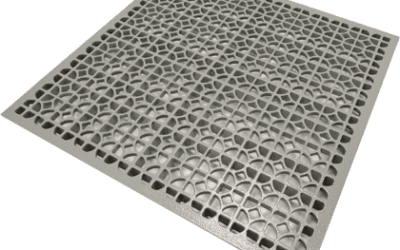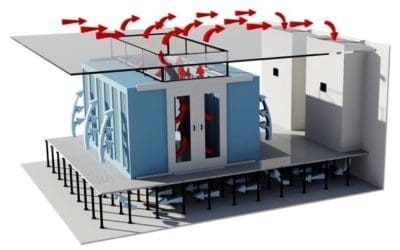Data centre infrastructure is undergoing a fundamental shift, toward higher density, stricter compliance, and increasingly sustainability-led design decisions. In this evolution, the materials used in rack-level components are receiving closer scrutiny.
Nowhere is this more important than in airflow management systems such as blanking panels and cable containment.
Flame-retardant ABS, certified to UL94 V-0, plays a vital role in minimising fire propagation risks inside server cabinets. Its properties align with emerging 2025 data centre fire protection standards, offering safety, performance, and environmental compliance in one engineered material.
For infrastructure managers balancing uptime with risk, this material choice is no longer secondary; it’s strategic.
What Is Flame-Retardant ABS (UL94 V-0)?
Acrylonitrile Butadiene Styrene (ABS) is a high-performance thermoplastic known for its impact resistance and dimensional stability. When manufactured to meet UL94 V-0, ABS becomes flame-retardant, meaning it self-extinguishes within 10 seconds and produces no flaming drips when tested under vertical burn conditions.
This safety rating is achieved through precise chemical formulations that maintain the ABS’s structural integrity while resisting ignition. In rack environments where heat buildup, cabling density, and airflow management converge, this level of fire resistance is critical.
At EziBlank®, every modular blanking panel is constructed from UL94 V-0-rated ABS. These panels are not only compliant with EIA-310-D rack standards but also designed with intuitive snap-on installation, supporting both airflow containment and safety in a single unit.
Fire Safety Compliance in 2025: Material Matters
As fire safety standards tighten across regions, particularly in Europe, Asia-Pacific, and North America, material certification is being prioritised in both new data centre builds and retrofits. Standards such as NFPA 75, BS EN ISO 4589-2 (LOI testing), and EN 61386 for conduit systems are now commonly referenced in rack-level audits.
Insurers and regulators are placing increased emphasis on:
- Flame rating certifications (UL94, EN 60695)
- Smoke and toxicity index scoring
- Halogen-free declarations
- Evidence of reusability and recyclability
Panels made from uncertified plastics or generic composites often fail to meet these multifaceted compliance benchmarks. By contrast, a flame-retardant ABS panel that has passed glow wire testing at 960°C and meets low smoke requirements can support both risk mitigation and environmental goals.
Within modern cold aisle containment systems, using panels that contribute to fire resistance is an integrated approach, not a separate line item.
Comparing ABS to Other Rack Panel Materials
When evaluating materials for blanking panels, several attributes directly affect fire safety and operational performance:
| Material | Flame Rating | Reusability | Weight | Smoke Emission | Thermal Stability |
| ABS (UL94 V-0) | Self-extinguishing | High | Light | Low | Excellent |
| Polycarbonate | Often V-2 or V-1 | Moderate | Medium | Moderate | Good |
| PVC | Variable | Low | Medium | High | Poor |
| Steel | Non-combustible | High | Heavy | None | Excellent |
ABS offers a balance that supports modern rack design, flame-retardant yet lightweight, reusable, and engineered for modularity. While steel provides excellent fire resistance, it lacks the ergonomic advantages of ABS, including tool-free installation and reduced installer fatigue.
Polycarbonate may offer some resistance but often falls short of the UL94 V-0 rating without additional chemical treatments, which can introduce environmental trade-offs.
The EziBlank® Modular Safety System
Engineered for performance, the EziBlank modular blanking panel system integrates flame-retardant ABS with ergonomic design to deliver rack-level fire mitigation without compromising airflow control.
Each panel features:
- UL94 V-0 rated ABS material for compliance with fire safety standards
- Snap-on clip architecture for tool-free installation
- Compatibility across 19″, 21″, and 23″ EIA-310-D and ETSI racks
- Reusable, lightweight form factor for low-maintenance operation
By using these panels to seal unused RU and SU spaces, data centres reduce hot air recirculation and mitigate the risk of micro-hotspots that can lead to ignition under thermal stress.
The system also aligns with cold aisle containment and supports integration with tailor-made airflow solutions, including ducted returns and modular wall systems.
The ability to implement airflow management and material compliance simultaneously is what defines EziBlank’s approach to thermal safety.
What Your Rack Fire Audit Will Look Like in 2025
The 2025 data centre fire audit landscape is evolving to reflect new risk profiles. Materials will no longer be assessed solely on mechanical fit, but on flame behavior, toxicity, and environmental impact.
Key inspection criteria are expected to include:
- UL94 V-0 certification visibly marked or documented
- LOI test results (typically requiring ≥28%)
- Presence of glow wire testing documentation (IEC 60695)
- Proof of halogen-free formulation (chlorine- and bromine-free)
- Evidence of product reusability and low-smoke emission
EziBlank panels meet each of these benchmarks. For rack-level compliance, facilities can reference datasheets directly through the Snap-On Panel Installation Guide or request performance documentation aligned with their operational requirements.
With global insurers and hyperscale operators now mandating third-party verified materials for high-density server environments, deploying non-compliant or uncertified fillers may result in costly penalties or worse, fire spread in uncontained rack zones.
Fire Safety and Airflow Optimization Work Together
Choosing the right material is not only about fire suppression; it’s about maintaining environmental stability at the rack level. In thermally sensitive zones, airflow leakage creates turbulence, undermines cooling efficiency, and contributes to uneven thermal loads.
By deploying UL94 V-0 blanking panels, operators close unused rack openings, improve directional airflow, and stabilize internal thermal gradients. This contributes to:
- Lower fan energy use (in CRAC or CRAH units)
- Reduced overcooling and wasted capacity
- Less strain on sensors and temperature regulation software
EziBlank panels integrate seamlessly into EkkoSense AI Optimization platforms, allowing operators to visualise airflow performance at the micro-zone level.
This alignment between passive components (like panels) and intelligent systems (like AI thermal software) is now fundamental to efficient, scalable data centre operation.
Retrofitting with UL94 V-0 Panels: A Low-Impact Upgrade
Legacy rack environments often contain filler panels or ad hoc airflow blockers made from mixed or untested plastics, many of which degrade over time, emit toxic fumes, or warp under temperature load.
Retrofitting with EziBlank modular panels provides a low-impact upgrade path:
- Installers can remove old panels and snap in new UL94 V-0 panels without tools
- Reusability reduces waste and aligns with ESG targets
- Lightweight design minimises load on vertical rails and improves technician ergonomics
Facilities upgrading airflow containment zones can combine panel retrofits with Tailor-Made Airflow Solutions, custom configurations that integrate floor tiles, wall systems, and AI monitoring for holistic containment control.
In retrofit scenarios, simplicity is key to safety. Panels that install in seconds, without sharp edges, latches, or screws, create a safer environment for maintenance staff while advancing compliance.
Safer, Smarter, and Audit-Proof with EziBlank
In 2025, the materials used inside your racks will carry the same scrutiny as the infrastructure surrounding them. Safety, airflow, compliance, and sustainability are no longer isolated metrics; they are interconnected pillars of responsible data centre design.
EziBlank UL94 V-0 flame-retardant blanking panels give data centre teams the ability to act on all four, with a single component engineered for performance and longevity.
Designed for containment, cooling, and risk mitigation, these panels reflect EziBlank’s philosophy: where minimalist design meets maximum impact.
To upgrade your rack safety, reduce thermal risk, or ensure compliance with upcoming fire standards, explore our Modular Blanking Panels or speak with our team for tailored recommendations.
FAQs, Flame-Retardant ABS & Rack Protection
What does UL94 V-0 mean for data centre materials?
UL94 V-0 is a flame classification that indicates a material will stop burning within 10 seconds on a vertical specimen and will not produce flaming drips. For rack components, this level of flame resistance is often required by global data centre compliance frameworks.
Why is ABS preferred over steel for blanking panels?
ABS is significantly lighter than steel, supports tool-free installation, and is safer to handle during maintenance. When flame-retardant and UL94 V-0 rated, ABS delivers both structural and thermal reliability while maintaining airflow integrity.
Is halogen-free the same as flame-retardant?
No. Halogen-free refers to the absence of chlorine, fluorine, bromine, and other toxic gas-producing elements. While important for air quality during fires, it does not guarantee self-extinguishing behavior. EziBlank panels are both halogen-free and flame-retardant.
How do blanking panels contribute to fire prevention?
By eliminating airflow recirculation zones, blanking panels reduce hot spots, areas where thermal buildup may trigger ignition. Flame-retardant panels provide an added layer of safety by resisting flame spread if exposed to electrical faults or high heat.
Can EziBlank panels be used in older rack systems?
Yes. EziBlank’s modular panels are compatible with 19”, 21”, and 23” racks, including ETSI standards. Their snap-on design allows for retrofitting without tools, ideal for legacy data halls requiring safety and airflow upgrades.




